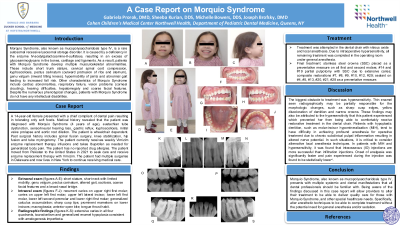Syndromes/Craniofacial Anomalies
307 - Case Report on Morquio Syndrome


Gabriela Prorok, DMD (she/her/hers)
Pediatric Dental Resident
Cohen Children’s Medical Center of Long Island Jewish Hospital, Queens, NY
Cohen Children's Medical Center of Long Island Jewish Hospital
Maspeth, New York, United States- SK
Sheeba Kurian, DDS
Chief & Program Director
Northwell Health Cohen Children's Medical Center
New Hyde Park, New York, United States - SK
Sheeba Kurian, DDS
Chief & Program Director
Northwell Health Cohen Children's Medical Center
New Hyde Park, New York, United States
Presenting Author(s)
Co-Author(s)
Program Director(s)
Case Report on Morquio Syndrome
Prorok, G, Kurian, S
Cohen Children’s Medical Center, Northwell Health, New Hyde Park, NY
Introduction: Morquio Syndrome, also known as mucopolysaccharidosis type IV, is a rare autosomal recessive lysosomal storage disorder caused by a deficiency in the enzyme N-acetylgalactosamine-6-sulfatase, resulting in an excess of glycosaminoglycans in the bones, cartilage and ligaments. Patients with Morquio Syndrome develop multiple musculoskeletal abnormalities, including short trunk stature, cervical spinal cord compression, kyphoscoliosis, pectus carinatum, genu valgum, hypermobility of joints and abnormal gait. Other characteristics of Morquio Syndrome include cardiac abnormalities, respiratory failure, vision problems, hearing difficulties, hepatomegaly and coarse facial features.
Case Report: A 14-year-old female presented to the Pediatric Dental Clinic at Cohen Children’s Medical Center with a chief compliant of dental pain. Medical history revealed that the patient was diagnosed with Morquio Syndrome at 4 years of age, eustachian tube dysfunction, sensorineural hearing loss, gastric reflux, kyphoscoliosis, mitral valve prolapse and aortic root dilation. The patient is wheelchair dependent. Past surgical history includes spinal fusion surgery, knee stabilization, hip fusion and tube myringotomy. The patient currently receives weekly Vimizim enzyme replacement therapy infusions and takes Ibuprofen as needed for generalized body pain. The patient has no reported drug allergies. Clinical examination revealed generalized decay, recurrent decay, generalized calculus, sharp cusp tips, prominent mamelons on lower incisors, macroglossia, anterior open bite and tongue thrust habit. Radiographic findings revealed generalized enamel hypoplasia. This report discusses the dental management and challenges faced while treating this patient.
Identify Supporting Agency and Grant Number:

.jpg)